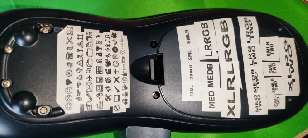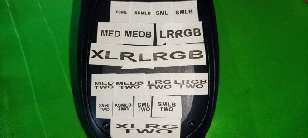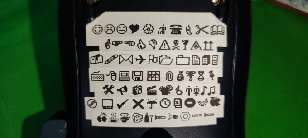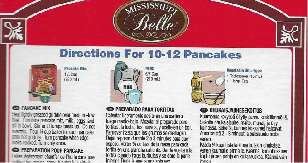Rick's b.log - 2022/12/26
You are 18.224.30.6, pleased to meet you!
Rick's b.log - 2022/12/26 |
|
| It is the 18th of December 2024 You are 18.224.30.6, pleased to meet you! |
|
mailto: blog -at- heyrick -dot- eu
Here is a close-up of the sizes/styles. I have only included bold as in all the many years I've owned the labeller, I've never used italics or the various frames and whatever else it can do (shadow?).
You'll notice that I have overlaid Large and X-Large with the bold variation using a diagonal cut. This is because once we get beyond Medium size, there isn't actually much difference between bold and regular. It seems as if the physical print size cannot get any larger (what is that, 32 pixels?), so it compensates by stretching the text. I tend to view X-Large as MODE 2. ☺
I also printed out the various symbols available that are not punctuation/maths/Greek. There are actually two (?) more strips to add, but I ran out of both space and print ribbon. I've just ordered a replacement from Amazon (€6! original part).
I thought it was a bit weird that nobody had made a project of hooking one of these things up to an Arduino or ESP chip. In theory (famous last words!) it should be a matter of pulsing the pixels in order to print a row, and then advancing the roller one line. I'm guessing it's a stepper motor.
But a quick look at Amazon likely explains why. You can get cheap little Bluetooth labellers for around €30. A Dymo one (Letratag 200B) which is basically the same mechanism as my labeller hooked to an app on a phone is only €42 - but appears to be as rudimentary as the Letratag, while a more capable device such as the Phomemo M110 (a Chinese gizmo) looks a lot more capable and runs it at €60-70 depending on how many rolls of stickers are wanted. Maybe rather than thinking about hacking the Dymo, it would be less bother to just get one of those?
Thing is, I don't make labels often, so I don't imagine that I'll be needing anything more capable really...
So after uploading this, I would like to make pancakes. Proper pancakes that rise, not these thin French things that are invariably served with butter, sugar, and nutella as typical options. FFS, people, maple syrup!
Whatever, it's no problem.
A sticker underneath (added for the French market) says that it contains generically modified soy and corn, which is interesting given that the ingredients are Wheat flour, sugar, salt, levening (E500, E341, E450) and anti-caking agent E170. Those E numbers are soda-bic, tricalcium phosphate (stops the flour clumping, aids raising), disodium pyrophosphate (combines with soda-bic to release CO2 bubbles), and calcium carbonate (stops the flour clumping).
Anyway, just mix 210ml of milk with a little vegetable oil, an egg, and... what?
1 1/8th of a cup of the pancake mix.
Okay, I get that Americans use cups to measure stuff because it keeps things very simple (though one could argue an eighth of a cup isn't especially simple), but to translate a weight as a liquid measurement... what the actual hell?
I Googled, and got pretty much everything from around 80g to 300g. You see, the problem with measuring by volume is that it's great if you have something of that volume (as I'm sure an American will have "a cup"), however things get quite complicated when translating volume into weight because things don't weigh the same. Flour is fairly light, sugar is heavier, butter heavier yet.
Over on this side of the ocean, we use a weight measurement for non-liquids, and a liquid measurement for liquids. This allows proper measurement, and also neatly sidesteps issues like "heaped or flat" and "sifted or poured", all of which can affect the final amount by a significant amount if you're dealing in volume.
As it happens, 1ml of water is 1g, so 100ml of water is 100g. It's more or less the same for milk, but it the density of vegetable oil is less than that of water so 100ml of oil is around 82-95g depending on what sort of oil you're talking about, however the common ones (rapeseed/canola, and sunflower are ~92g/100ml with olive oil being a fraction lighter). Useful if you're in a hurry, but if accuracy is important, measure liquids by volume.
I finally tracked down a site that specified 125g/US cup for flour. I'm going to assume that pancake mix weighs the same as flour, since that's mostly what it is. Add in that extra bit and, well, I can't be arsed to actually pull out the calculator, so I'm going to just say "140g sounds about right".
I don't think I could hack living in America. Forget the whole God & Guns issue, nor the deplorable state of medical care or the absymal lack of employee rights... Forget all of that. It's the utterly moronic cooking measurements that would do my head in.
PS: US measurements don't match their Imperial (British) equivalents either. <sigh> Thank whoever you believe in for the sane Metric system.
Dymo labeller styles
I wanted to print out a little label that said "Yamaha" for the little power brick for my keyboard. Both so that I remember what it's for without looking at the rating label, and also so I remember not to plug it into my Roland (which, annoyingly, has the power connector wired up the other way around - outer positive).
It took a couple of tries in order to arrive at the correct size. So I decided that instead of guessing the sizes, which wastes a lot of ribbon because the labeller spits out huge amounts on either side of that which is actually printed, I would print out examples and stick them to the back so I can look at an example and know immediately what size/style to select.

Label examples.
Sizes and styles.
Most of the available symbols.Stupid American measurements

Pancake instructions.
I have a pack of Mississippi Belle pancake mix. Proudly made in USA, it says so on the box.
Now, I could believe if it said generically modified flour, and it probably is, but there's no soy or maize (corn) in this product at all...
Which they have "helpfully" translated in the most asinine way to be 280 millilitres.
By contrast, 100g of flour is 100g of flour regardless of what you put it in or how hard you press it down.
Which is, coincidentally, exactly half of the translated liquid measurement marked on the pack. Pity anybody that didn't notice the "ml" and tried dosing out 280g of mix...
David Pilling, 27th December 2022, 19:02 Rob, 28th December 2022, 04:36
| © 2022 Rick Murray |
This web page is licenced for your personal, private, non-commercial use only. No automated processing by advertising systems is permitted. RIPA notice: No consent is given for interception of page transmission. |